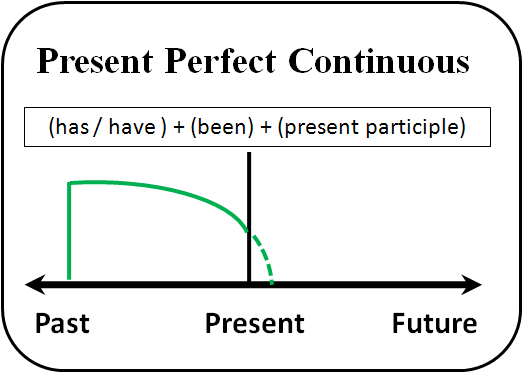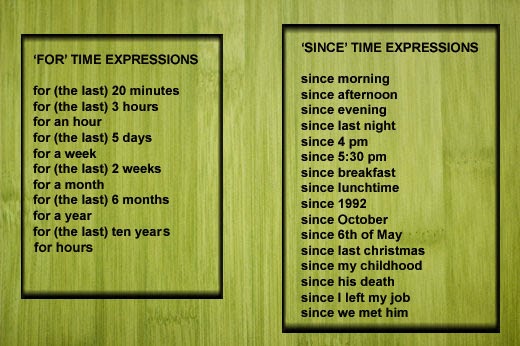
Present Perfect Continuous Tense in English
The present perfect continuous is used to refer to an unspecified time between ‘before now’ and ‘now’. The speaker is thinking about something that started but perhaps did not finish in that period of time. He/she is interested in the process as well as the result, and this process may still be going on, or may have just finished.ACTIONS THAT STARTED IN THE PAST AND CONTINUE IN THE PRESENT
She has been waiting for you all day (= and she’s still waiting now). I’ve been working on this report since eight o’clock this morning (= and I still haven’t finished it). They have been travelling since last October (= and they’re not home yet).ACTIONS THAT HAVE JUST FINISHED, BUT WE ARE INTERESTED IN THE RESULTS
She has been cooking since last night (= and the food on the table looks delicious). It’s been raining (= and the streets are still wet). Someone’s been eating my chips (= half of them have gone).
FORMING THE PRESENT PERFECT CONTINUOUS
The present perfect continuous is made up of two elements: the present perfect of the verb ‘to be’ (have/has been), and the present participle of the main verb (base+ing)| Subject | has/have been | base+ing |
| She | has been | swimming |
EXAMPLE: PRESENT PERFECT CONTINUOUS, TO LIVE
| Affirmative | Negative | Interrogative |
|---|---|---|
| I have been living | I haven’t been living | Have I been living? |
| You have been living | You haven’t been living | Have you been living? |
| He, she, it has been living | He hasn’t been living | Has she been living? |
| We have been living | We haven’t been living | Have we been living? |
| You have been living | You haven’t been living | Have you been living? |
| They have been living | They haven’t been living | Have they been living? |

VERBS WITHOUT CONTINUOUS FORMS
With verbs not normally used in the continuous form, use the simple present perfect instead (verbs such as: know, hate, hear, understand, want). I’ve wanted to visit China for years. She’s known Robert since she was a child. I’ve hated that music since I first heard it. I’ve heard a lot about you recently. We’ve understood everything.USE 1 Duration from the Past Until Now
 We use the Present Perfect Continuous to show that something started in the past and has continued up until now. “For five minutes,” “for two weeks,” and “since Tuesday” are all durations which can be used with the Present Perfect Continuous.
We use the Present Perfect Continuous to show that something started in the past and has continued up until now. “For five minutes,” “for two weeks,” and “since Tuesday” are all durations which can be used with the Present Perfect Continuous.
Examples:
- They have been talking for the last hour.
- She has been working at that company for three years.
- What have you been doing for the last 30 minutes?
- James has been teaching at the university since June.
- We have been waiting here for over two hours!
- Why has Nancy not been taking her medicine for the last three days?
USE 2 Recently, Lately
 You can also use the Present Perfect Continuous WITHOUT a duration such as “for two weeks.” Without the duration, the tense has a more general meaning of “lately.” We often use the words “lately” or “recently” to emphasize this meaning.
You can also use the Present Perfect Continuous WITHOUT a duration such as “for two weeks.” Without the duration, the tense has a more general meaning of “lately.” We often use the words “lately” or “recently” to emphasize this meaning.
Examples:
]]>
- Recently, I have been feeling really tired.
- She has been watching too much television lately.
- Have you been exercising lately?
- Mary has been feeling a little depressed.
- Lisa has not been practicing her English.
- What have you been doing?
